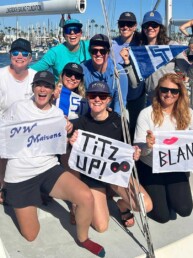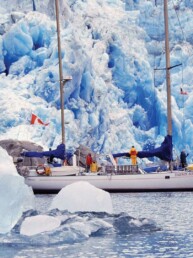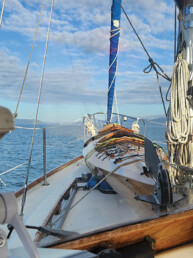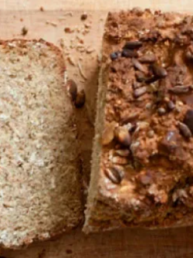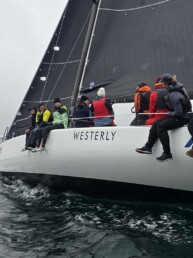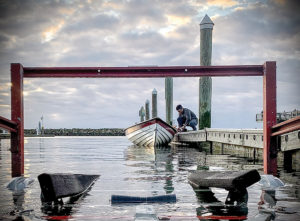
This article was originally published in the November 2021 issue of 48° North
The spring flow of the Badua’t/Mad River in Northern California was a chorus of ripples. Next to it was a rocky pond temporarily separated from the main channel by a few feet. In it floated a green canoe. Ethan sat in the stern with his guitar. On his instrument, printed with a black marker in block letters, were the words “This Machine Floods Echo Chambers so Hope can Float Again.” He sang, “I can’t swim…” and strummed.
A fallen redwood provided a backdrop to the other side of the pond. Musicians Turtle and Logan sat perched on the considerable trunk, backlit by the setting sun. By their silhouette, they might have been miners or cowboys from another century. I stood in the pond, legs burning from an afternoon in the frigid water. My left hand held the canoe to stabilize it; the other had my iPhone, filming the scene.
A year earlier in Seattle, as humanity stared into the abyss of a global pandemic, my housemate Rolando and I went for a row. We slipped Clarabelle from the trailer into the water at the Golden Gardens boat ramp. She’s a 16.5-foot Gig Harbor Boat Works Jersey Skiff, with blue eyes on her bow that give her the look of a playful Labrador awaiting a walk. To her credit, this cute and sturdy vessel has two trips down the Mississippi River, and at least 2,100 miles in rowing tours on Lake Union. Rowing has had an outsized influence on my life. I fell in love 20 years ago, and rowboats have even taken me across the ocean twice. Well, almost twice, but that’s another story.
We pulled north and then northwest. Across Puget Sound was a distant green carpet of trees, sweeping up to jagged snow-capped Olympic Mountains partially obscured by clouds. Wood oars splashed rhythmically. Waves lapped the hull with steady percussion and the occasional slap of something bigger promising a livelier row north of Meadow Point. On the shore, folks bundled in jackets huddled in small groups.
As we approached the point, still in the wind’s lee, a lively brass melody joined the rhythm of the waves. Twisting towards the sound, I observed the outline of a dinghy. I changed course towards the music.
In the dinghy sat a grizzled man with a saxophone. He played with gusto. The falling sun sparkled off the instrument. My cheeks pinched to a grin.
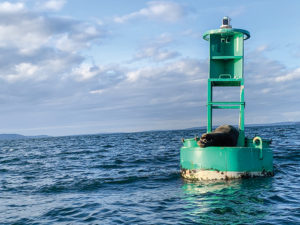 Rolando and I continued north past the green buoy. A sea lion was resting on it and turned its head lazily to acknowledge our presence. Waves grew and rocked the hull just enough to remind me of being at sea. I wondered when I would get out into the middle of the ocean again.
Rolando and I continued north past the green buoy. A sea lion was resting on it and turned its head lazily to acknowledge our presence. Waves grew and rocked the hull just enough to remind me of being at sea. I wondered when I would get out into the middle of the ocean again.
Later that night, mixed in with a phone full of horrors, was the grainy image of Italians singing from their quarantine houses into their cobblestone streets. Combined with the unexpected saxophone concert in a tiny boat, I felt verklempt. We were going to be shut inside for a while, and I felt the overwhelming urge that we, or at least I, needed something beautiful.
After a couple nights’ sleep I asked myself if that experience a few days prior was so meaningful to me because of the moment, or was there more to this idea? I asked my friend Sandy to come out and play. She sat in the stern in a pile of pillows and blankets, snug in several layers with technicolor tights, and she strummed her ukulele to a swirling tide. Like a tiny boat, we ultimately occupy our mortal vessel for the moment we have on this journey. A song played on this boat seemed to echo a reason we create — to extend beyond ourselves to be seen and heard.
This image spoke to me but with none of that clarity. It just felt good, and I threw myself to it with the righteousness of a fresh convert. I invited other friends and musicians to come out and play on my tiny rowboat; but no one got back to me for days and, by the end of the week, I felt a little foolish. Then, that Friday, people began to respond. Over a weekend, I filmed or collected 44 songs from 11 artists — the last one only an hour before the governor signed the stay-at-home order. I called it ‘Tinyboatsession’ and began posting a song a day.
One of these sessions was with Eric Levy. He lived in Eagle Harbor aboard a white-hulled Westsail 32 with tanbark sails. It was named Velella after the pelagic invertebrate that floats on the surface, known by its more romantic name, By the Wind Sailor. Velella was clean, almost pristine for her age. A set of solar panels and a wind vane looked recently installed. Below deck, the layout was simple, with handsome wood embellishments. Eric mentioned modestly, but with pride, that much of it he carved himself, down to wooden bowls and spoons. The only nod to dockside domesticity was a burgundy Turkish rug — roll that up, and Velella seemed ready to go to sea. Indeed, that was his plan the following year.
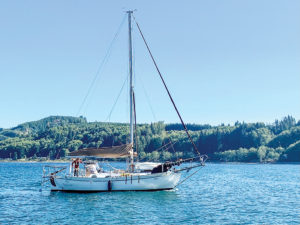 He grabbed his guitar off the bulkhead, and we stepped gingerly into Velella’s dinghy, appropriately named Barnacle. I rowed him around under low clouds and brisk blustery winds. We found quiet spots under piers with a background of forests, flapping flags, ferry boats, and the distant Seattle skyline. When I left, I gave him a copy of the book I’d written about one of my ocean rows as a thank you.
He grabbed his guitar off the bulkhead, and we stepped gingerly into Velella’s dinghy, appropriately named Barnacle. I rowed him around under low clouds and brisk blustery winds. We found quiet spots under piers with a background of forests, flapping flags, ferry boats, and the distant Seattle skyline. When I left, I gave him a copy of the book I’d written about one of my ocean rows as a thank you.
I fell into the rhythm of posting a daily Tinyboatsession on social media and rowed as much as I could. After a month and a half, I was out of songs and decided to find more. By early summer, I had another 63.
In the middle of filming this second season, Eric called to tell me he enjoyed my book. As we chatted, he mentioned work had furloughed him. This inspired him to move his voyage up by a year. In a little over a month, he’d sail to Hawaii and back. The slump of activity during his first few weeks of the pandemic was now followed by a flurry of projects. I wished him luck with a brief twinge of jealousy at his upcoming voyage.
Summer progressed. I quit my job and started doing freelance work. In the background, I kept posting daily Tinyboatsessions into a world that was feeling too harsh for this kind of whimsy. Then Eric called again. His friend could only join for the first leg of the trip, and he did not want to singlehand back to Seattle.
In mid August, I stood by a buzzing fly-filled dumpster in Lahaina that smelled of rotting fish. I stripped off my sweaty Tyvek suit and masks I’d worn on the 5-hour flight. Since I was getting on a boat, I wanted to minimize risk. I was pretty sure the Tyvek was useless in this application, but it had the virtue of encouraging folks to give me a wide berth. Now in boardshorts and a tank top, I grabbed my dry bags and headed over to the wharf to see Eric tying up Barnacle. He looked ten shades darker, and his shoulder was glossy with the blood and ink of a fresh tattoo. I stepped into the dinghy, and we rowed out to the outline of Velella at anchor in front of a pink setting sun.
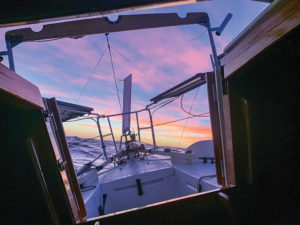 After a few days of quarantining and provisioning, Velella galloped north on a beam reach. As the land faded away, so did the last bars of connectivity from my phone, leaving us with a small satellite tracker as our only invisible tether to land. It felt good to disconnect. I’d posted the last Tinyboatsession a few days before. Perhaps the entire purpose of Tinyboatsession was to get me out to sea again? This was a hell of a crescendo.
After a few days of quarantining and provisioning, Velella galloped north on a beam reach. As the land faded away, so did the last bars of connectivity from my phone, leaving us with a small satellite tracker as our only invisible tether to land. It felt good to disconnect. I’d posted the last Tinyboatsession a few days before. Perhaps the entire purpose of Tinyboatsession was to get me out to sea again? This was a hell of a crescendo.
That first evening we both sat on the deck, clipped into the jack lines, and took turns passing out through the night. By morning, queasiness passed and we fell into a steady rhythm of trimming sails, cooking, conversing, and reading over cups of coffee in the morning and the occasional dram of rum in the afternoon.
Meeting so many artists over recent months had been an inspiration, and at the prodding of a friend, I bought a harmonica. I made a goal of playing a few one-minute songs, including “My Bonnie Lies Over the Ocean,” “Amazing Grace,” and the theme to Jurassic Park. It was humbling and, even at my rudimentary level, it felt like a magic trick. Eric was not only tolerant but encouraging, though I would not have blamed him if he consigned the harmonica to Davy Jones’ locker.
When the weather wasn’t too rough, Eric pulled his guitar off the bulkhead and strummed and crooned to a panorama of sherbet-colored sunsets; calm, overcast days; and windy, cold evenings below deck while dinner cooked on the stove. The limitations of my phone camera and its single microphone made filming a challenge and delight. Sounds of a boat at sea both competed and collaborated with the music. Water swirling past the hull. Wind in the shrouds. That creaking of a boat under a full head of sail. The world in all its dynamic form was happening, the music played on, and I was reminded that all boats are tiny at sea.
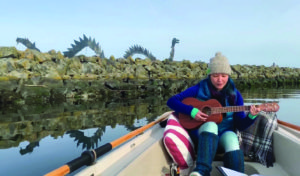 A day before we sighted shore, a fresh gale blistered the cobalt water of the North Pacific. It blew out and left a violet sunset that might have been the best of the trip. The following day, the sun rose so clear I could see Vancouver Island’s Coast Range more than one hundred miles away. A small yellow bird and a white moth landed on the deck to rest. The bird flew away, but the moth did not. By morning, we made the mouth of the Strait of Juan de Fuca. Humpback whales played and fed in the white caps. By Clallum Bay, we sailed into a wall of smoke. The West Coast was still on fire. We landed and found COVID case numbers rising. I scheduled a Tinyboatsession, and it rained. The world seemed to close up again. Perhaps it was not the right time for songs in tiny boats. Maybe it wouldn’t be again?
A day before we sighted shore, a fresh gale blistered the cobalt water of the North Pacific. It blew out and left a violet sunset that might have been the best of the trip. The following day, the sun rose so clear I could see Vancouver Island’s Coast Range more than one hundred miles away. A small yellow bird and a white moth landed on the deck to rest. The bird flew away, but the moth did not. By morning, we made the mouth of the Strait of Juan de Fuca. Humpback whales played and fed in the white caps. By Clallum Bay, we sailed into a wall of smoke. The West Coast was still on fire. We landed and found COVID case numbers rising. I scheduled a Tinyboatsession, and it rained. The world seemed to close up again. Perhaps it was not the right time for songs in tiny boats. Maybe it wouldn’t be again?
The season changed. Smoke gave way to rain and clouds. I drove to New Mexico to visit my parents and family for Christmas. Their house overlooks the Rio Grande. Paths to the river weave through twisted cottonwoods and an oxbow pond under a stark blue sky. I took daily walks to look at and hear running water. Occasionally, my thoughts turned to how music in tiny boats had led me back to the middle of the sea. I resolved to start as soon as I got back home. However, after a dozen more trips past the oxbow, it registered that this little pond was plenty big for a tiny boat and what a wonderful juxtaposition of songs in a tiny boat in the desert would be to songs in the sea.
My brother’s old scoutmaster had a broken red canoe. I fixed it and reached out into the digital world. Over a week and a half, I filmed flamenco, country, rock-and-roll, jazz, and Algerian music. At one of these sessions, Stella, a hard-rocking ballad-singing cowgirl, asked, “Are you going to get more songs? Because you should stop in Humboldt.”
Why just Humboldt? I thought. There was an entire California coast to drive past to get back home again. Season Three began. I would look for a boat. When I had a boat, I’d contact musicians and then hope it all would line up. It worked! Tiny boats and songs led me to Long Beach, Lake Cachuma, Santa Barbara, Sausalito, Oakland, and Tomales Bay, where I had the privilege of taking the legendary Rambling Jack Elliott out in
his dory named Jan.
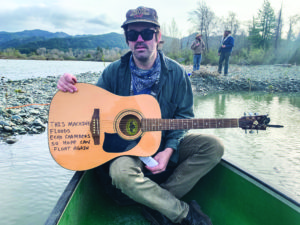 Almost a month later, I made it to Blue Lake, California, on the banks of the Badua’t/ Mad River in Humboldt county. After an afternoon of filming on a warm, clear day, the sun had fallen and springtime was cold again. Most of the musicians that made an impromptu tiny boat concert had gone home except Turtle and Logan of the Rinky Dink String Band.
Almost a month later, I made it to Blue Lake, California, on the banks of the Badua’t/ Mad River in Humboldt county. After an afternoon of filming on a warm, clear day, the sun had fallen and springtime was cold again. Most of the musicians that made an impromptu tiny boat concert had gone home except Turtle and Logan of the Rinky Dink String Band.
Ethan had almost not come. When he arrived, he told me he had a nightmare about the river, was terrified of the water, and could not swim. I told him he didn’t have to swim and showed the water’s depth by walking into the middle of the pond. This assuaged his doubts and he played. At the end of his final song, Ethan handed me his guitar.
“Get this thing away from me,” he quipped.
Carefully removing his hat and sunglasses, he dove from the canoe into the cold water. Turtle followed after him, leaping from the fallen redwood with a splash.
I headed home to Puget Sound; a year had passed since the first Tinyboatsession. Two-hundred songs were tucked into the phone in my pocket — starting with a skiff in Seattle, from a sailboat in the middle of the sea to a canoe on a shallow muddy river thousands of feet above the ocean, and a coast full of songs in between.
A few months later I was out for another sunset row with a friend in front of Golden Gardens. The unmistakable sound of a saxophone in a tiny boat came lilting across the water. It was the man who created the moment that started it all. I waited till he finished and introduced myself with the enthusiasm of a fanboy, relating the story.
The man cocked his head, paused in reflection.
“Huh. Weird,” he replied,
“You’re not wrong,” I laughed, thanked him, and turned my thoughts towards Season Four.
Check out the music at www.tinyboatsession.com
Jordan Hanssen
Jordan Hanssen is a writer who spends a lot of time in tiny boats. Check out his book “Rowing into the Son,” take one of his rowboat tours of Seattle, or learn more about his hijinks at www.jordanhanssen.com.

